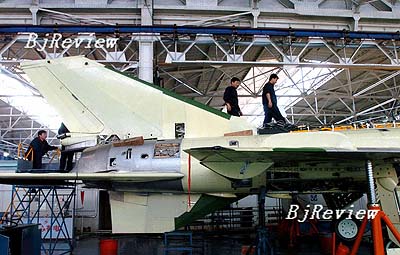|

Without a transformation 42 years ago, would there be a brand named "Changhong" in the world? It might be impossible to answer this question.
When people use Changhong electric appliances, they might only be aware that these products are from a large international company located in Sichuan Province, southwest China. Many people, including young Changhong employees, know nothing about the transformation of the company four decades ago.
In 1958, the state-run Sichuan Radio Factory was established on the site of today's Changhong Group. As a military industrial factory, it mainly produced airborne fire control radar. Employees had to accept strict security checks upon entry and exit. In 1965, however, the factory began to produce products for civilian use and its name was changed to the Changhong Machine Factory. Eight years later, the factory developed its first TV set and registered its trademark. Now, Sichuan Changhong Electric Co. Ltd., a listed company solely initiated and held by Changhong Machine Factory, has become a comprehensive multinational integrating research and development, production, sales and service of TV sets, air conditioners, refrigerators, information technology, telecommunications devices, digital receivers, chips, commercial electronics and components. Gradually, Changhong has become an internationally competitive brand and service supplier of computer, communications and consumer electronics. In 2005, Changhong was named one of the world's top 500 brands and in early 2007, its brand value was estimated at 58.33 billion yuan ($7.88 billion).
In the past few decades, "switching from military to civilian" has promoted the birth of many large competitive companies in China.
100 billion yuan of output
Yu Liegui, Vice Minister of the Commission of Science, Technology and Industry for National Defense (CSTIND), says that the core aim of "switching from military to civilian" is to serve the national economy through utilizing the military technologies and capabilities that have been developed over the years.
At a press conference held in Sichuan on November 19, Hu Yafeng, Deputy Secretary General of the CSTIND, said that more than 30,000 advanced military technologies have been adapted for civilian use, creating an output of nearly 100 billion yuan ($13.51 billion).
Since many military industrial enterprises are located in Sichuan, it has experienced the brunt of "switching from military to civilian." Breakthroughs have been made in such industries as nuclear, aviation, photoelectric information and specialty chemical technologies, greatly improving local economic development.
According to Hu, the massive production switchover from military to civilian occurred after the late 1970s. As an important part of the state development strategy, the Chinese Government incorporated the transformation into national economic and social development planning. The CSTIND became responsible for directing the transformation.
Capital is an important factor in the development of the changes. The government encourages and requires enterprises to collect capital through state investment, to introduce foreign investment and private capital, and encourages restructuring of military transforming to civilian production with enterprises in different industries, different regions and with different ownership.
According to Yu, between 2000 and 2005, products for civilian use coming from military enterprises grew at an annual average of 19 percent. The transformation contributed 30 percent to the growth of annual output in the civil shipping, aerospace, aviation and nuclear energy industries. Breakthroughs have been made in technology research and product development in the fields such as large liquefied natural gas ships, the new generation of large launch vehicle, civil satellites and applications and new feeder line aircraft.
Focusing on hi-tech
"In China's military industrial research and production system, two thirds of the capacity has been switched over to serve national economic development, and the output value of products for civilian use has accounted for over 65 percent of the total output of military industrial enterprises," said Sun Laiyan, Vice Minister of the CSTIND.
According to Sun, China will further establish a timely, standard and coordinated system to declassify scientific research achievements in order to give support to the development of dual-use technologies.
The CSTIND has organized experts to carry out feasibility assessments on projects that will see a switchover in 2008. The assessment is expected to be completed by mid-December. In 2008, major support will be devoted to 16 projects in the fields of new materials, alternative energy, as well as optical, mechanical and electronic integration.
At the same time, military industrial enterprises are expanding projects for civilian use. At a conference held in Sichuan on November 20 promoting the development of dual-use technologies, 64 contracts were signed with a total value of more than 30.5 billion yuan ($4.12 billion).
According to Sun, the aim of the CSTIND is to speed up development of hi-tech industries that adopt similar structures, technologies, techniques and equipment with military products and enhance the capability of switching military technologies to civilian use. | 